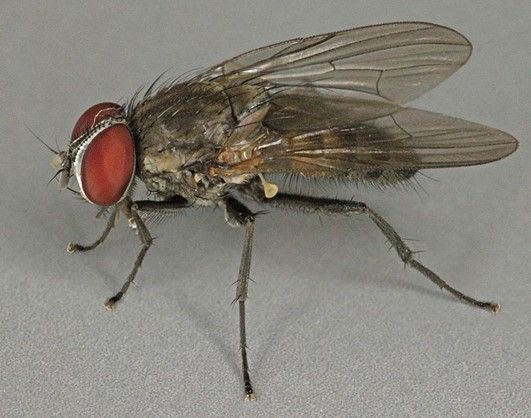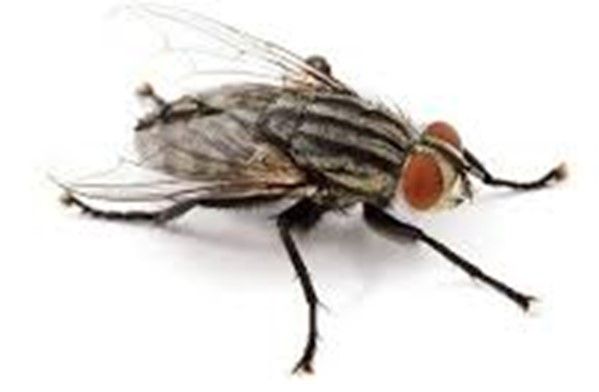1) House fly

Fig 1. House fly
It is 4 to 6 mm long and gray to black. The thorax has four black stripes. The fourth wing vein has a sharp upward bend to almost join the third at the tip of the wing. The fly prefers to breed in decaying animal excrement but will also develop in garbage and vegetable waste. High populations are sometimes found close to poultry and livestock facilities.
Common Name: House fly
Scientific Name: Musca domestica
Habitat: Garbage, plant waste, animal feces, rotting food
Biology and Behavior: The house fly is a non-biting filth fly with sponge-like mouthparts. It can be identified by four distinct longitudinal stripes on the dorsum of its thorax. It breeds in garbage, plant waste, and animal feces. It may develop from egg to adult in 10 days under optimal conditions. In addition to their unsanitary breeding sites, house flies regurgitate and defecate upon surfaces where they feed or rest. Because of these behaviors, house flies have been implicated as competent vectors of typhoid fever, cholera, diarrhea, parasitic worms, and Salmonella.
2) Flesh fly

Fig 2. Flesh fly
It is 8 mm long and dull-grayish with three strips on the thorax. The abdomen has a checkerboard gray pattern. Many species have a red tip on the abdomen and red eyes. The flesh fly breeds on decaying meat, fish, and garbage. It lays live larvae on meats and scraps.
Common Name: Flesh fly
Scientific Name: Sarcophaga spp.
Habitat: Fresh carcasses, road-kill, meat wastes, animal feces
Biology and Behavior: Flesh flies resemble large, robust-looking house flies. They are distinguished by three dark longitudinal stripes on their thorax and have a red-tipped abdomen. Flesh flies are strong fliers and are among the first flies to colonize a fresh carcass. Instead of depositing eggs, the adult female deposits a live larva on the food source. The presence of flesh flies may indicate the presence of a fresh carcass, but they may also survive on animal manure, spoiled meat, and exposed dog food. Small rodents or birds that die within an attic or wall void provide a sufficient breeding site for flesh-fly infestation inside a structure.
3) Humpbacked fly

Fig 3. Humpbacked fly
It is about 3 mm long with a dull black body. The antennae are one-segmented. Wings have three posterior veins with no cross veins. It breeds in decaying organic matter of high protein. Residues in trash cans and drains are the most frequent areas of breeding. It is frequently found in hospitals, nursing homes, and supermarkets.
Common Name: Phorid fly, humpbacked fly, scuttle fly, coffin fly
Scientific Name: Megaselia scalaris
Habitat: Gelatinous and/or fermenting organic materials, liquefied carcasses, sewage, drains
Biology and Behavior: Phorid flies are members of the family Phoridae and may be identified by their hump-backed appearance and only three veins on their wings. These flies are small enough to enter obscure cracks and crevices that contain fermenting organic material and suitable moisture. Phorid flies can breed in drains and are known to squeeze into caskets and infest mausoleums. They can subsist on any variety of organic material ranging from garbage and glue to dead bodies, as long as the material remains wet.
